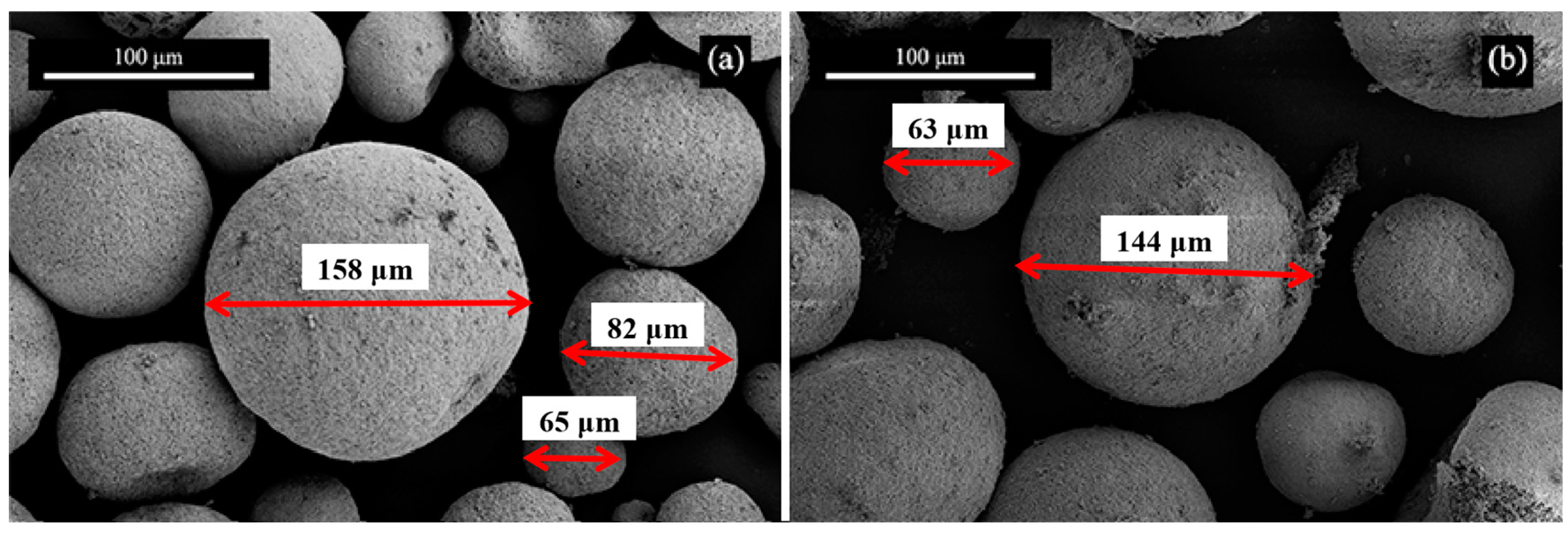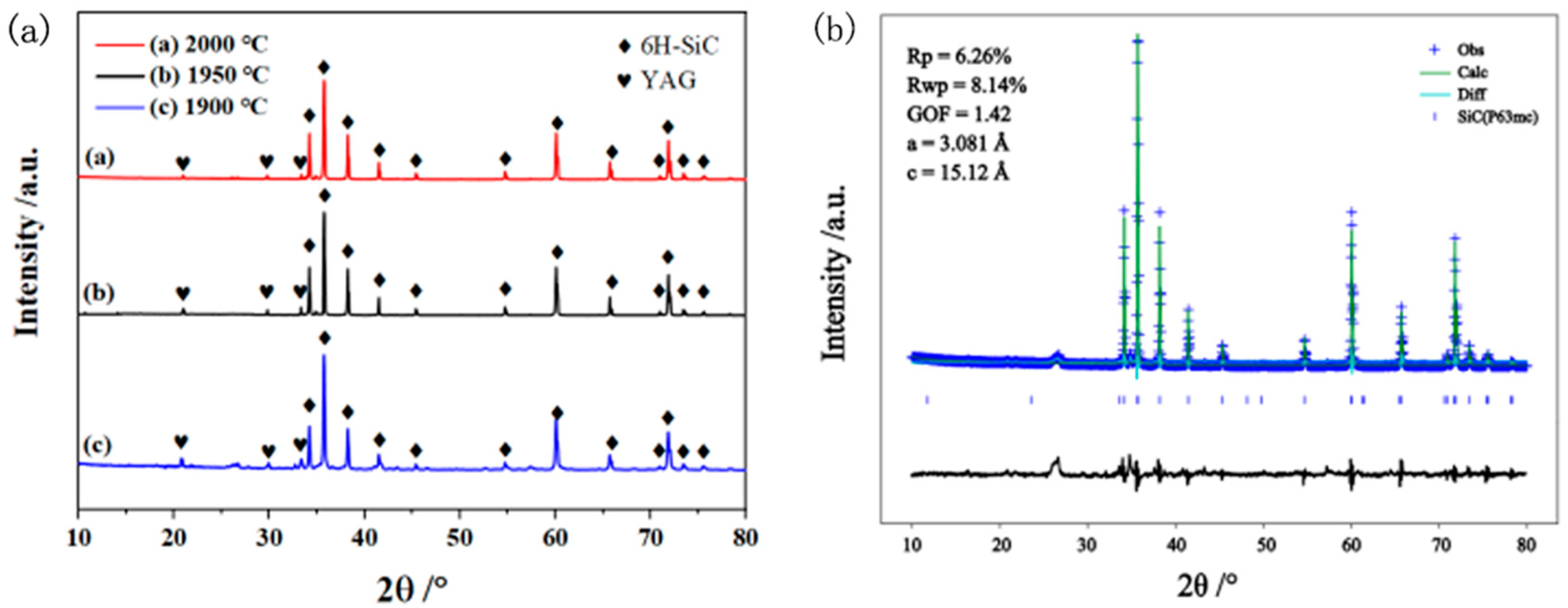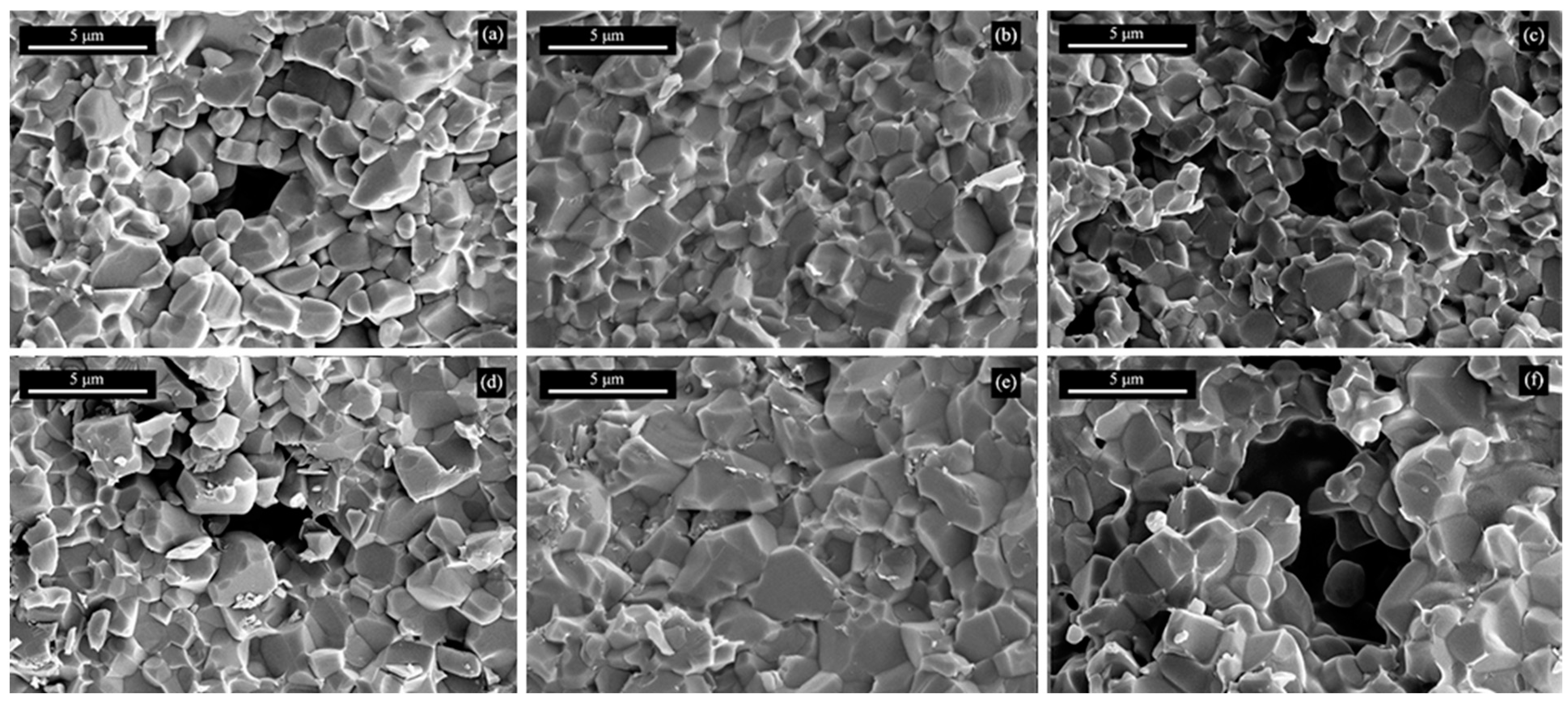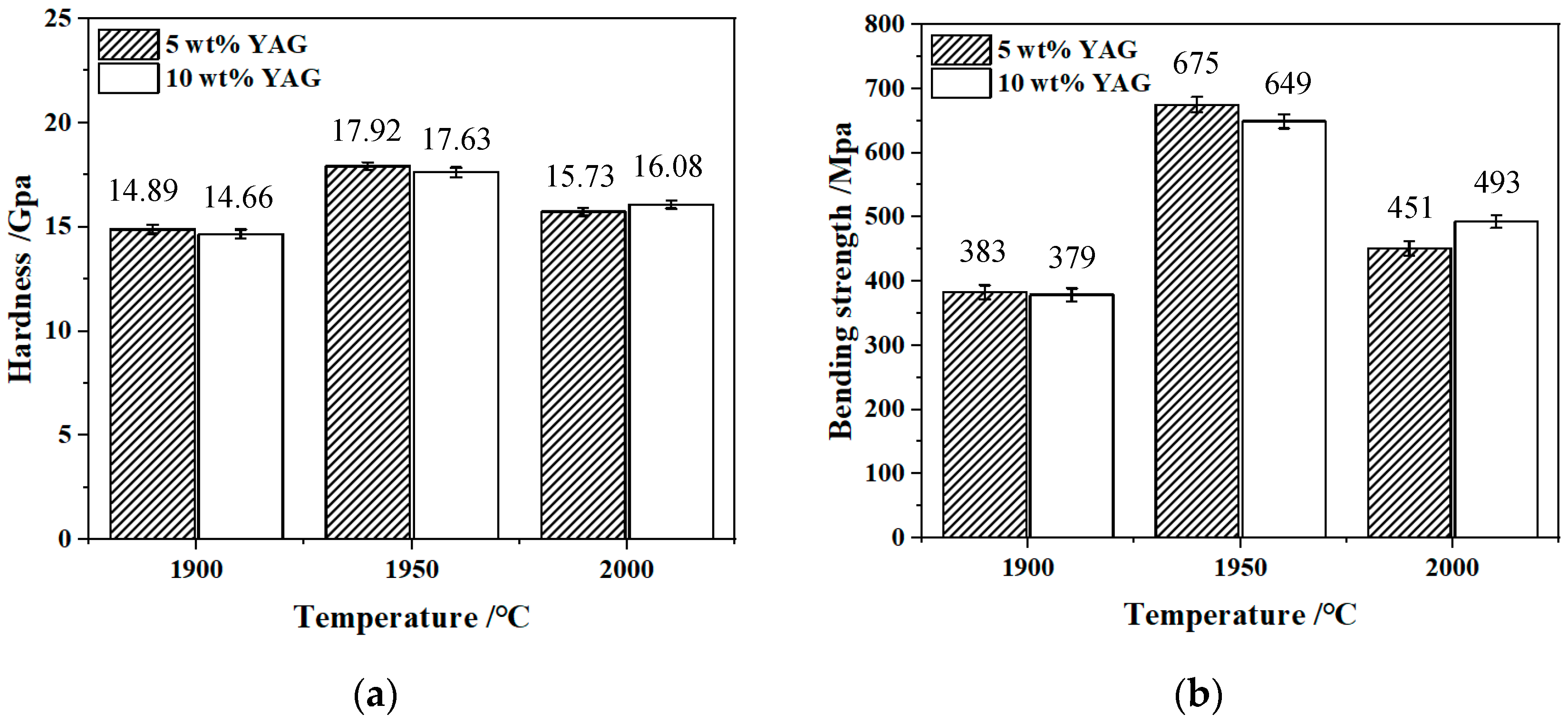Microstructure and Properties of Hot Pressing Sintered SiC/Y3Al5O12 Composite Ceramics for Dry Gas Seals
Abstract
:1. Introduction
2. Materials and Methods
2.1. Preparation of Silicon Carbide Composite Ceramic Materials
2.2. Characterization
3. Results and Discussion
3.1. Preparation of SiC/YAG Composite Ceramics by Hot Pressing Sintering
3.2. Sintering Behavior of Hot Pressing Sintered SiC/YAG Composite Ceramics
3.3. Microstructure of Hot Pressing Sintered SiC/YAG Composite Ceramic
3.4. Mechanical Properties of Hot Pressing Sintered SiC/YAG Composite Ceramic
4. Conclusions
Author Contributions
Funding
Institutional Review Board Statement
Informed Consent Statement
Data Availability Statement
Conflicts of Interest
References
- Hahn, M.; Park, Y.; Kang, M.; Jun, S.; Jang, G. Effects of Laminar, Turbulent, and Slip Conditions in a Fluid Film on a Dry Gas Seal. Machines 2022, 10, 954. [Google Scholar] [CrossRef]
- Raju, K.; Yoon, D.H. Sintering additives for SiC based on the reactivity: A review. Ceram. Int. 2016, 42, 17947–17962. [Google Scholar] [CrossRef]
- Khodaei, M.; Yaghobizadeh, O.; Alhosseini, S.H.N.; Esmaeeli, S.; Mousavi, S.R. The effect of oxide, carbide, nitride and boride additives on properties of pressureless sintered SiC: A review. J. Eur. Ceram. Soc. 2019, 39, 2215–2231. [Google Scholar] [CrossRef]
- Chrétien, L.; Bonnet, L.; Boulesteix, R.; Maître, A.; Sallé, C.; Brenier, A. Influence of hot isostatic pressing on sintering trajectory and optical properties of transparent Nd:YAG ceramics. J. Eur. Ceram. Soc. 2016, 36, 2035–2042. [Google Scholar] [CrossRef]
- Wang, Z.L.; Wang, Q.Y.; Hao, M.M.; Li, X.Y.; Liu, K.W. The effect of thermal-elastic deformation on the sealing performance of supercritical CO2 dry gas seal. Ind. Lubr. Tribol. 2023, 75, 950–958. [Google Scholar] [CrossRef]
- Deng, Q.G.; Sun, X.J.; Xu, H.J.; Mao, W.Y. Thermal Characteristics of Dry Gas Seal in Startup Process Considering Microscale Effects. Lubricants 2023, 11, 503. [Google Scholar] [CrossRef]
- Zhang, C.; Jiang, J.B.; Peng, X.D.; Zhang, X. An Investigation on Phase Transitions in a Supercritical CO2 Dry Gas Seal. Tribol. Trans. 2022, 65, 728–748. [Google Scholar] [CrossRef]
- Biswas, K.; Rixecker, G.; Aldinger, F. Gas pressure sintering of SiC sintered with rare-earth-(III)-oxides and their mechanical properties. Ceram. Int. 2005, 31, 703–711. [Google Scholar] [CrossRef]
- Sajgalík, P.; Sedlácek, J.; Lences, Z.; Dusza, J.; Lin, H.T. Additive-free hot-pressed silicon carbide ceramics-A material with exceptional mechanical properties. J. Eur. Ceram. Soc. 2016, 36, 1333–1341. [Google Scholar] [CrossRef]
- Gao, Q.; Sun, D.M.; Jiang, X.S.; Sun, H.L.; Zhang, Y.L.; Fang, Y.J.; Shu, R. Microstructure, interfacial characteristics, and wear performances of Cu-Fe-SiC cermet composites. Int. J. Appl. Ceram. Technol. 2023, 20, 2401–2411. [Google Scholar] [CrossRef]
- Malik, R.; Kim, Y.W. Effect of nitride addition on the electrical and thermal properties of pressureless solid-state sintered SiC ceramics. J. Korean Ceram. Soc. 2022, 59, 589–594. [Google Scholar] [CrossRef]
- Wang, S.F.; Hsu, Y.F.; Jiang, B.T.; Chao, K.K.; Liao, Y.L.; Liu, C.Y.; Bor, H.Y. Microstructure and mechanical properties of carbon-precursor-added B4C and B4C-SiC ceramics subjected to pressureless sintering. J. Eur. Ceram. Soc. 2023, 43, 4244–4254. [Google Scholar] [CrossRef]
- Yeom, J.A.; Kim, Y.W.; Jung, W.K.; Cheong, D.I.; Kang, E.S. Pressureless sintering of SiC ceramics with improved specific stiffness. J. Eur. Ceram. Soc. 2023, 43, 3941–3949. [Google Scholar] [CrossRef]
- Chahhou, B.; Roger, J. Reactive sintering and thermodynamics of Ti3SiC2/SiC composites. Ceram. Int. 2022, 48, 34635–34649. [Google Scholar] [CrossRef]
- Belyakov, A.N.; Markov, M.A.; Chekuryaev, A.N.; Bykova, A.D.; Duskina, D.A.; Perevislov, S.N. Investigation of the Reaction-Sintered B4C-SiC Materials Produced by Hot Slip Casting. Glass Phys. Chem. 2023, 49, 306–313. [Google Scholar] [CrossRef]
- Zhu, T.B.; Xie, Z.P. Ultrastrong tough zirconia ceramics by defects-engineering. J. Am. Ceram. Soc. 2022, 105, 1617–1621. [Google Scholar] [CrossRef]
- Kolek, A.N.; Cooper, S.R.; Behler, K.D.; Ghoshal, A.; Moore, T.W.; Wright, A.J.; Blair, V.L.; Reidy, R.F.; Young, M.L.; Voevodin, A.A.; et al. High-temperature ablation of hot-pressed HfC-SiC ceramics. Int. J. Appl. Ceram. Technol. 2024, 21, 1010–1021. [Google Scholar] [CrossRef]
- Papynov, E.K.; Portnyagin, A.S.; Modin, E.B.; Mayorov, V.Y.; Shichalin, O.O.; Golikov, A.P.; Pechnikov, V.S.; Gridasova, E.A.; Tananaev, I.G.; Avramenko, V.A. A complex approach to assessing porous structure of structured ceramics obtained by SPS technique. Mater. Charact. 2018, 145, 294–302. [Google Scholar] [CrossRef]
- Simonenko, E.P.; Simonenko, N.P.; Simonenko, T.L.; Grishin, A.V.; Tal’skikh, K.Y.; Gridasova, E.A.; Papynov, E.K.; Shichalin, O.O.; Sevastyanov, V.G.; Kuznetsov, N.T. Sol-gel synthesis of SiC@Y3Al5O12 composite nanopowder and preparation of porous SiC-ceramics derived from it. Mater. Chem. Phys. 2019, 235, 9. [Google Scholar] [CrossRef]
- Choutapalli, S.H.; Kumar, H.G.P.; Paneerselvam, E.; Vasa, N.J.; Jayaganthan, R. Influence of spark plasma sintering and reaction bonded SiC targets on pulsed laser deposition of 6H-SiC thin films. Appl. Phys. A-Mater. Sci. Process. 2022, 128, 1063. [Google Scholar] [CrossRef]
- Al-Jothery, H.K.M.; Albarody, T.M.B.; Sultan, N.M.; Mohammed, H.G.; Megat-Yusoff, P.S.M.; Almuramady, N.; Al-Nidawi, W.J.A. Sintering β-SiC nanopowder using novel microwave-current assisted sintering technique: Preliminary study. Adv. Nat. Sci.-Nanosci. Nanotechnol. 2023, 14, 035013. [Google Scholar] [CrossRef]
- Nallusamy, T.; Vijayakumar, S. Reinforcements, Manufacturing Techniques, and Respective Property Changes of Al2O3/SiC Based Composites: A Review. Silicon 2022, 14, 3129–3146. [Google Scholar] [CrossRef]
- Swab, J.J.; Pittari, J.J., III; Meredith, C.S. Anisotropy in the compression strength of hot-pressed ceramics. J. Mater. Sci. 2023, 58, 15603–15616. [Google Scholar] [CrossRef]
- Perevislov, S.N. Investigation of the Phase Composition and Analysis of the Properties of Sintered and Hot-Pressed Materials Based on Silicon Nitride. Refract. Ind. Ceram. 2022, 63, 66–73. [Google Scholar] [CrossRef]
- Potanin, A.Y.; Pogozhev, Y.S.; Loginov, P.A.; Patsera, E.I.; Rupasov, S.I.; Levashov, E.A. Chemical conversion during transient liquid-phase hot pressing of TaSi2-TaC-SiC SHS-powder. Ceram. Int. 2023, 49, 21839–21847. [Google Scholar] [CrossRef]
- Neuman, E.W.; Hilmas, G.E.; Fahrenholtz, W.G. Transition metal diboride-silicon carbide-boron carbide ceramics with super-high hardness and strength. J. Eur. Ceram. Soc. 2022, 42, 6795–6801. [Google Scholar] [CrossRef]
- Yang, Y.; Zhu, T.; Liao, N.; Li, Y.; Liang, X.; Xie, Z.; Sang, S.; Dai, J. Preparation of graphene nanoplatelets reinforced SiC composites by oscillatory pressure sintering. Ceram. Int. 2022, 48, 20563–20570. [Google Scholar] [CrossRef]
- Li, S.; Luo, X.; Zhao, L.; Wei, C.; Gao, P.; Wang, P. Crack tolerant silicon carbide ceramics prepared by liquid-phase assisted oscillatory pressure sintering. Ceram. Int. 2020, 46, 18965–18969. [Google Scholar] [CrossRef]
- He, H.; Zhao, R.; Tian, H.; Shao, G.; Wang, H.; Fan, B.; Lu, H.; Xu, H.; Zhang, R.; An, L.-n. Sintering behavior of alumina whisker reinforced zirconia ceramics in hot oscillatory pressing. J. Adv. Ceram. 2022, 11, 893–900. [Google Scholar] [CrossRef]
- Fan, L.; Li, J.; Huang, Y.; Gao, Y.; Yang, S.; An, L. Hot oscillatory pressing of B4C ceramics for improving densification and mechanical properties. J. Am. Ceram. Soc. 2022, 105, 5039–5044. [Google Scholar] [CrossRef]
- Yang, Y.; Zhu, T.; Sun, N.; Liang, X.; Li, Y.; Wang, H.; Xie, Z.; Sang, S.; Dai, J. Mechanical and tribological properties of SiC whisker-reinforced SiC composites via oscillatory pressure sintering. Int. J. Appl. Ceram. Technol. 2023, 20, 2499–2510. [Google Scholar] [CrossRef]
- Tamari, N.; Tanaka, T.; Tanaka, K.; Kondoh, I.; Kawahara, M.; Tokita, M. Effect of spark plasma sintering on densification and mechanical-properties of silicon-carbide. J. Ceram. Soc. Jpn. 1995, 103, 740–742. [Google Scholar] [CrossRef]
- Ren, K.; Xia, J.; Wang, Y. Grain growth kinetics of 3 mol. % yttria-stabilized zirconia during flash sintering. J. Eur. Ceram. Soc. 2019, 39, 1366–1373. [Google Scholar] [CrossRef]
- Hinoki, T.; Kano, F.; Kondo, S.; Kawaharada, Y.; Tsuchiya, Y.; Lee, M.; Sakai, H. Development of Liquid Phase Sintering Silicon Carbide Composites for Light Water Reactor. Coatings 2022, 12, 623. [Google Scholar] [CrossRef]
- Lee, J.Y.; Hinoki, T. Densification behavior of monolithic SiC fabricated by pressureless liquid phase sintering method. Open Ceram. 2022, 11, 100289. [Google Scholar] [CrossRef]
- Alekseeva, L.S.; Nokhrin, A.V.; Karazanov, K.O.; Orlova, A.I.; Boldin, M.S.; Lantsev, E.A.; Murashov, A.A.; Chuvil’deev, V.N. Mechanical Properties and Thermal Shock Resistance of Fine-Grained Nd:YAG/SiC Ceramics. Inorg. Mater. 2022, 58, 199–204. [Google Scholar] [CrossRef]
- Alekseeva, L.S.; Nokhrin, A.V.; Orlova, A.I.; Boldin, M.S.; Lantsev, E.A.; Murashov, A.A.; Chuvil’deev, V.N.; Moskvichev, A.A. Thermal Conductivity of Fine-Grained Nd:YAG/SiC Composite Ceramics for Inert Fuel Matrices. Inorg. Mater. 2023, 59, 661–667. [Google Scholar] [CrossRef]
- Yuan, Y.; Fan, J.; Li, J.; Liu, J.; Zhao, K.; Liu, D.; An, L. Oscillatory pressure sintering of Al2O3 ceramics. Ceram. Int. 2020, 46, 15670–15673. [Google Scholar] [CrossRef]
- Deng, Q.; Song, P.; Xu, H.; Mao, W. Current Progress of Dry Gas Seal Dynamics. Lubr. Eng. 2018, 43, 118. [Google Scholar]
- Guo, X.-Z.; Yang, H. Sintering and microstructure of silicon carbide ceramic with Y3Al5O12 added by sol-gel method. J. Zhejiang Univ. Sci. B 2005, 6, 213–218. [Google Scholar] [CrossRef] [PubMed]
- Guo, X.; Yang, H.; Zhu, X.; Zhang, L. Preparation and properties of nano-SiC-based ceramic composites containing nano-TiN. Scr. Mater. 2013, 68, 281–284. [Google Scholar] [CrossRef]








| Sample | Bulk Density (g/cm3) | Weight-Loss Ratio (%) | Relative Density (%) | Crystalline Phases | ||
|---|---|---|---|---|---|---|
| Major | Secondary | |||||
| SiC/5 wt% YAG | 1900 °C | 3.072 | 8.11 | 93.14 | 6H-SiC | YAG |
| 1950 °C | 3.223 | 9.34 | 98.53 | 6H-SiC | YAG | |
| 2000 °C | 3.201 | 11.23 | 96.55 | 6H-SiC | YAG | |
| SiC/10 wt% YAG | 1900 °C | 3.131 | 8.93 | 94.85 | 6H-SiC | YAG |
| 1950 °C | 3.216 | 10.66 | 98.41 | 6H-SiC | YAG | |
| 2000 °C | 3.203 | 13.07 | 96.22 | 6H-SiC | YAG | |
| Sample | Sintering Conditions | Bending Strength (MPa) | Fracture Toughness (MPa·m1/2) | Reference |
|---|---|---|---|---|
| SiC/5 wt% YAG | 1900 °C/30 MPa/1 h/Ar | 383 ± 38 | 4.51 | This work |
| 1950 °C/30 MPa/1 h/Ar | 675 ± 43 | 5.56 | ||
| 2000 °C/30 MPa/1 h/Ar | 451 ± 49 | 4.80 | ||
| SiC/10 wt% YAG | 1900 °C/30 MPa/1 h/Ar | 379 ± 41 | 4.45 | |
| 1950 °C/30 MPa/1 h/Ar | 649 ± 45 | 5.52 | ||
| 2000 °C/30 MPa/1 h/Ar | 493 ± 37 | 4.79 | ||
| SiC/10 wt% YAG | 1950 °C/1 h/Ar | 437 | 4.9 | [40] |
| SiC/5 wt% TiN | 1950 °C/1 h/Ar | 545.2 | \ | [41] |
Disclaimer/Publisher’s Note: The statements, opinions and data contained in all publications are solely those of the individual author(s) and contributor(s) and not of MDPI and/or the editor(s). MDPI and/or the editor(s) disclaim responsibility for any injury to people or property resulting from any ideas, methods, instructions or products referred to in the content. |
© 2024 by the authors. Licensee MDPI, Basel, Switzerland. This article is an open access article distributed under the terms and conditions of the Creative Commons Attribution (CC BY) license (https://creativecommons.org/licenses/by/4.0/).
Share and Cite
Zou, C.; Ou, Y.; Zhou, W.; Li, Z.; Zheng, P.; Guo, X. Microstructure and Properties of Hot Pressing Sintered SiC/Y3Al5O12 Composite Ceramics for Dry Gas Seals. Materials 2024, 17, 1182. https://doi.org/10.3390/ma17051182
Zou C, Ou Y, Zhou W, Li Z, Zheng P, Guo X. Microstructure and Properties of Hot Pressing Sintered SiC/Y3Al5O12 Composite Ceramics for Dry Gas Seals. Materials. 2024; 17(5):1182. https://doi.org/10.3390/ma17051182
Chicago/Turabian StyleZou, Chang, Yangxin Ou, Weiliang Zhou, Zhiqiang Li, Pu Zheng, and Xingzhong Guo. 2024. "Microstructure and Properties of Hot Pressing Sintered SiC/Y3Al5O12 Composite Ceramics for Dry Gas Seals" Materials 17, no. 5: 1182. https://doi.org/10.3390/ma17051182






